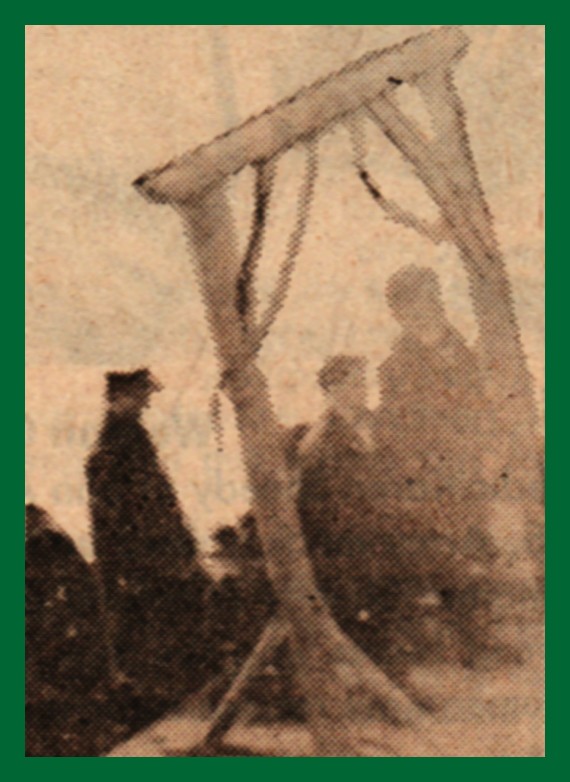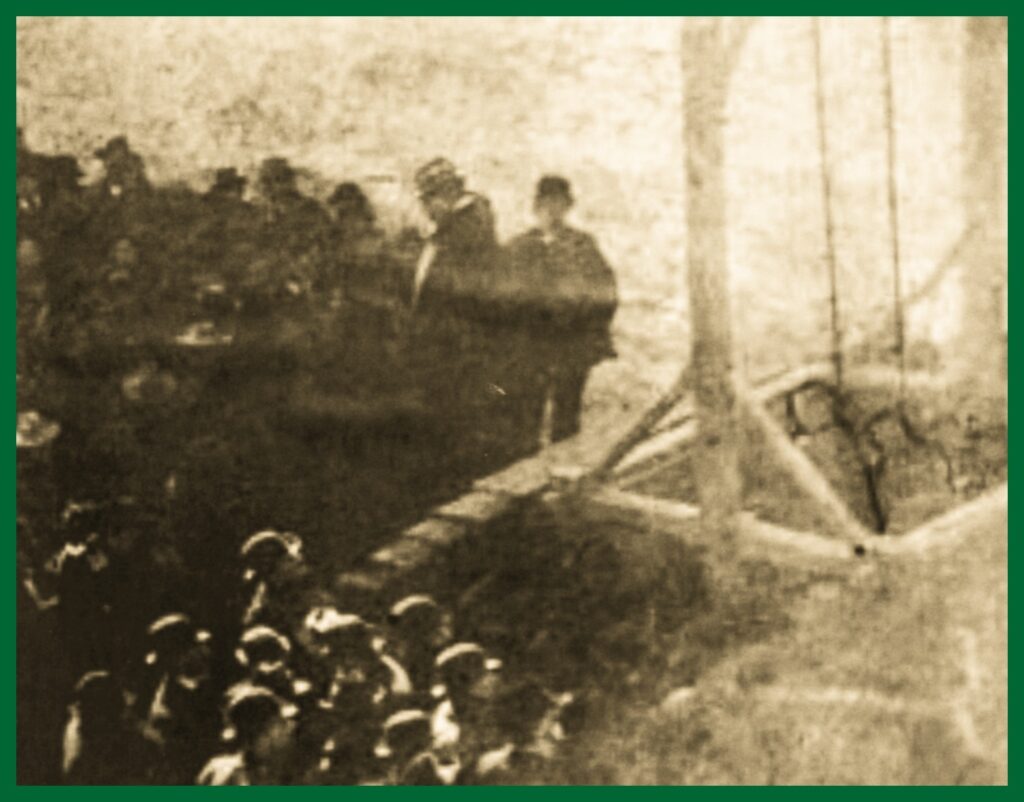A photograph of the two Halifax Bank killers on the scaffold in Harrisburg, as they were being prepared for the “drop” that would end their lives. The photo appeared in a column by Paul B. Beers, “Reporter at Large,” Harrisburg Patriot, February 8, 1980.
A photograph of the two Halifax Bank robbers after the drop. This photo appeared in Halifax Bank Robbery, March 14, 1901, and Halifax Banking History, by Pearl Bretz Hain, published by the Halifax Area Historical Society, 2017.
Both photograph were taken by Samuel Kuhnert, from Halifax, who was said to be Pennsylvania’s first aerial photographer.
According to Pearl Hain:
[Kuhnert’s] collection of photographs from the air and on land are in the State Archives in Harrisburg…. Prior to World War I, he invented a camera lens to take distant photographs from the air. He sold his patent to the… government during World War I to aid in the war effort against Germany, thereby aiding our military… to capture photos of factories, roads, railroad tracks, rivers, etc.
In order to get himself in a position to take the photos, Kuhnert had to get on a ladder to be on top of the 23-foot limestone wall around the jail yard where the hanging took place. This would be the second hanging that Kuhnert would photograph and both had a Halifax connection. On July 23, 1901, the Elmer E. Barner hanging took place at the same jail yard. Barner went to his death for the killing of his brother-in-law, Isaac W. Miller, who was from Halifax. Two photos have been seen of the Barner hanging and both are reproduced in the Pearl Hane book on the Halifax Bank Robbery.
Paul B. Beers, in his column, explained how he got the photos:
In his recent, privately published autobiography, Judge Robert E. Woodside mentions the turn-of-the-century Halifax bank robbery and hanging. The judge was a boyhood chum of the grandchildren of Charles W. Ryan, the slain cashier of the Halifax Bank.
What Woodside could not have known is that the hanging of Luther Keiper [sic] and Henry Rowe on January 18, 1902, in the old jail yard where the Walnut Street Parking Garage is today occasioned perhaps the only existing pictures of a Dauphin County execution.
The late Sam Kuhnert, as wily a photog as this newspaper ever had, either climbed the jail wall or leaned out a window from what was later Johnny Kobler‘s cafe to snap his pictures. The conditions must have been tough, because the quality of the shots aren’t up to usual Kuhnert standards. Shortly before his death, Sam asked me if I wanted these pictures. “I never turn down good hangings,” I replied.
Bob Woodside was born June 4, 1904, at 4 p. m. at his parents home on the southeast corner of Center and market Streets in Millersburg. “My life started,” he planned to write in his autobiography, but then in his meticulous fashion he remembered a Supreme Court opinion that cast doubts on whether life starts at conception, at the end of the first trimester or at birth. Such are the problems of contemporary autobiographers. His head full of legalisms, Woodside also let an opportunity pass to display his remarkable wit. He has been a life-long late riser, notorious in the legal fraternity for being the last one to get to the office. Blessed with a solid background in the law and a quick mind, he always could more than catch up in the work than his early-bird peers. In any case, Bob Woodside first saw the light of day when he wanted to – in the afternoon.
As a grammar-school kid, Woodside loafed at the home of Luther Ryan, son of the slain cashier. The Ryans were almost his second parents, and from them he heard the story of the murder and hangings.
Rowe and Keiper, kids from Wiconisco, arrived at the Halifax Bank in their buggy. Because there was little bank insurance and a successful robbery could ruin a bank, cashier Ryan put up a fight and was killed.
Justice was a lot faster in those days – and surer. Dauphin County had 22 known hangings, Cumberland four, and Perry one. In 10 months, Rowe and Keiper were hanged. In our era of capital punishment, the last electrocution from Dauphin County was in 1950 and from Cumberland County in 1954, and both were at Rockview Prison. Nobody from Perry County has ever gone to the chair.
The Ryans told Woodside what a great event that 1902 double-biller hanging was. The boys mounted the gallows spiffily dressed, complete with bow ties. The sheriff was from Upper Dauphin County, so he let 1,500 onlookers into the jail yard and permitted more to sneak in. The last meal of the condemned included homemade cookies.
Apparently there was no trouble getting them to the gallows. The late Al Hamman (1890-1960) was among the last to see a Dauphin County hanging. He used to tell the tale of a guy who in the last minute3s decided he didn’t want to go, and the sheriff had to strap him to a board and carry him out to the jail yard. Hamman was a local newspaperman in 1907, was on the first Evening News in 1917 and toiled a record 44 years for the Patriot-News.
Rowe and Keiper’s bodies were removed to the baggage car of the Lykens train. “The passengers, nearly all men, many drunk, were in a carnival mood,” writes Woodside, “and on the back seat of the last car sat the parents of the two boys.”
The Woodside memoirs take 208 pages, replete with pictures. The book is half autobiography and half a tribute to glorious Millersburg.
Funny, but few autobiographies have ever come out of this area. It is probably a result of the Dutch tradition of keeping the mouth shut. History is the poorer because Harve Taylor, George Bloom, Carl Shelley, Ed Beibleman, Mary Sachs, Bessie Jones, Rabbi David Philip Bookstaber, Parson Elder, Walter Sohn, Manny Meyers or Doc McBride never wrote their candid memoirs. Sen. William Maclay produced a diary with derogatory opinions of George Washington and his fellow congressmen, so he remains the most nationally quoted Harrisburger of all time.
A Pennsylvanian who missed being both chief justice and governor, Woodside was a Senate page, a five-term legislator, county judge for 10 years and Superior Court judge for 11, state attorney general and renowned constitutional reformer. Bob Woodside has hot had an insignificant career. He has been one of the most able Central Pennsylvanians of his day, and certainly one of the most widely respected.
His autobiography is entitled My Life and Town, in itself revealing how much a hometown boy Woodside has always been. As a man who didn’t lust for honors, he could have been just as happy sitting in a fireball chomping on a Rambo apple, talking baseball and wondering why Millersburgers call lunch “dinner.”
The memoirs are quietly revealing in a chattering yet documented fashion by a man once a Patriot stringer who went on to write hundreds of court opinions. What is most appealing is the Woodside love of people, natural beauty and events; in short, a love of life that sustains him till this day and makes him such an interesting writer to read.
_______________________________________________
See:
News article from the on-line resources of the Free Library of Philadelphia.
Corrections and additional information should be added as comments to this post.

